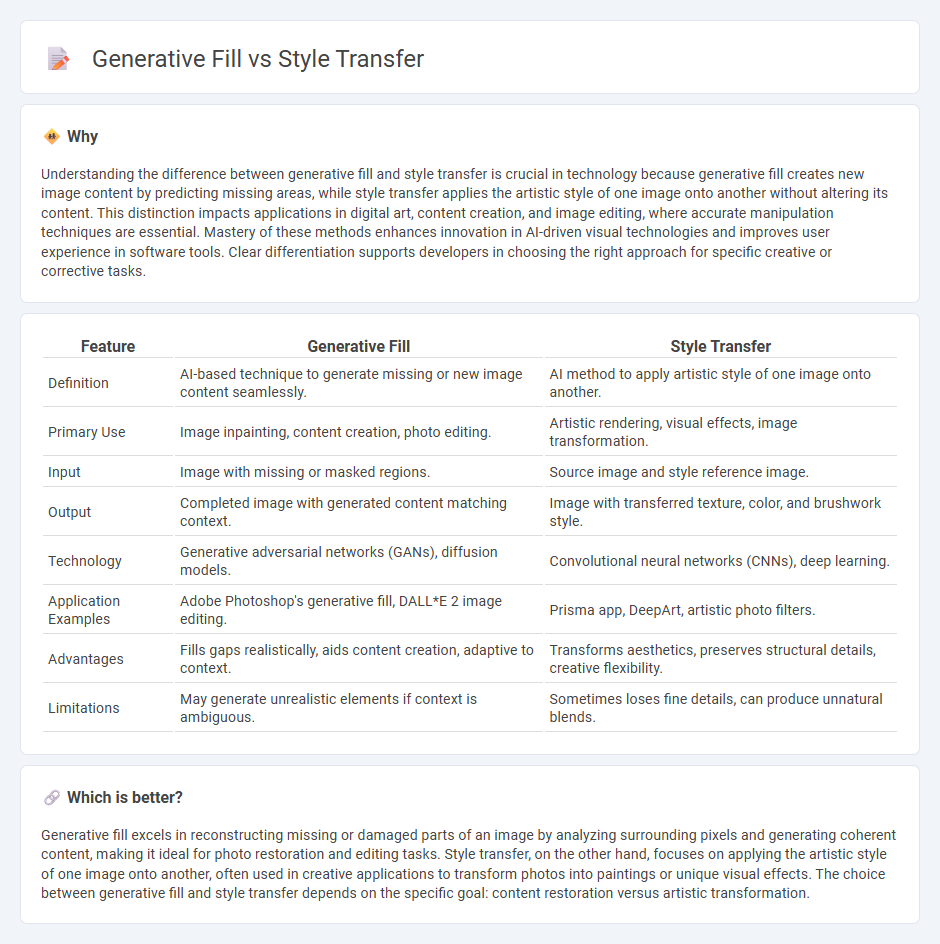
Generative fill leverages deep learning algorithms to intelligently complete missing parts of an image by analyzing surrounding pixels, creating seamless and realistic visuals. Style transfer, on the other hand, transforms an image's appearance by applying the textures and colors of a reference artwork while preserving its original content structure. Explore more to understand how these advanced AI techniques revolutionize digital creativity and design.
Why it is important
Understanding the difference between generative fill and style transfer is crucial in technology because generative fill creates new image content by predicting missing areas, while style transfer applies the artistic style of one image onto another without altering its content. This distinction impacts applications in digital art, content creation, and image editing, where accurate manipulation techniques are essential. Mastery of these methods enhances innovation in AI-driven visual technologies and improves user experience in software tools. Clear differentiation supports developers in choosing the right approach for specific creative or corrective tasks.
Comparison Table
| Feature | Generative Fill | Style Transfer |
|---|---|---|
| Definition | AI-based technique to generate missing or new image content seamlessly. | AI method to apply artistic style of one image onto another. |
| Primary Use | Image inpainting, content creation, photo editing. | Artistic rendering, visual effects, image transformation. |
| Input | Image with missing or masked regions. | Source image and style reference image. |
| Output | Completed image with generated content matching context. | Image with transferred texture, color, and brushwork style. |
| Technology | Generative adversarial networks (GANs), diffusion models. | Convolutional neural networks (CNNs), deep learning. |
| Application Examples | Adobe Photoshop's generative fill, DALL*E 2 image editing. | Prisma app, DeepArt, artistic photo filters. |
| Advantages | Fills gaps realistically, aids content creation, adaptive to context. | Transforms aesthetics, preserves structural details, creative flexibility. |
| Limitations | May generate unrealistic elements if context is ambiguous. | Sometimes loses fine details, can produce unnatural blends. |
Which is better?
Generative fill excels in reconstructing missing or damaged parts of an image by analyzing surrounding pixels and generating coherent content, making it ideal for photo restoration and editing tasks. Style transfer, on the other hand, focuses on applying the artistic style of one image onto another, often used in creative applications to transform photos into paintings or unique visual effects. The choice between generative fill and style transfer depends on the specific goal: content restoration versus artistic transformation.
Connection
Generative fill and style transfer both utilize deep learning techniques, particularly generative adversarial networks (GANs) and convolutional neural networks (CNNs), to manipulate and enhance images. Generative fill focuses on completing missing or damaged parts of an image by predicting and synthesizing plausible content, while style transfer reimagines an image's appearance by applying the aesthetic features and textures of another image. The connection lies in their shared reliance on feature extraction and generation processes to create visually coherent and stylistically consistent results.
Key Terms
Neural Networks
Style transfer leverages neural networks to extract and reapply the stylistic features of one image onto the content of another, utilizing convolutional neural networks (CNNs) to capture texture and color patterns. Generative fill employs advanced generative models like GANs or diffusion models to infer and synthesize missing or occluded regions in images by learning contextual and semantic information from large datasets. Explore how neural architectures differ in optimizing visual realism and creativity in image generation by diving deeper into these techniques.
Image Synthesis
Style transfer applies the artistic characteristics of a source image to a target image, preserving the content while transforming the style using deep neural networks. Generative fill, leveraging advanced models like GANs or diffusion-based architectures, synthesize missing or new image regions by understanding the surrounding context to create seamless content. Explore the evolving capabilities of these image synthesis techniques to enhance your creative projects.
Content Preservation
Style transfer modifies an image's appearance by applying the stylistic elements of a reference image while maintaining its original content structure, ensuring key features remain recognizable. Generative fill synthesizes new content based on surrounding context, which can result in significant alterations to the original image's content. Explore detailed comparisons to understand how each technique balances creativity and content preservation.
Source and External Links
Style Transfer Guide - Fritz ai - Style transfer is a computer vision technique that blends a content image with a style reference image to create an output that preserves the original content but appears painted in the style of the reference image, enabling users to generate artistic effects such as turning a selfie into a Van Gogh-style portrait.
Neural style transfer - Wikipedia - Neural style transfer (NST) uses deep neural networks to transform images or videos by adopting the style of another image, with roots in non-photorealistic rendering and notable implementations like the 2015 Gatys et al. algorithm, enabling creation of art that blends content and style from different sources.
The Best Free AI Style Transfer Tool - OpenArt - A free AI-based style transfer tool lets users transform ordinary photos into stunning artworks by transferring styles from one image to another in just a few clicks, supporting custom models and ensuring privacy of user images.
 dowidth.com
dowidth.com